Syracuse (415-413 BCE)
Q844289Siege of Syracuse (414-413): one of the most important campaigns during the Peloponnesian War. A well-equipped Athenian army blundered into disaster, was annihilated.
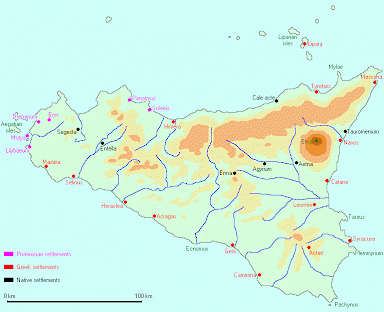
It is tempting to see the Sicilian Expedition as an act of hybris by an arrogant, imperial power. This is, at least, how it appears in our main source, the History of the Peloponnesian War by Thucydides. At the beginning of the sixth book, he suggests that Sicily was too large to conquer, and he presents the decision to sail to the far west as an act of irrational enthusiasm.
Changing Plans
Still, the initial plan to send a navy to Sicily was not a bad one. Athens had allies in the far west and and was morally obliged to support them. Initially, the Athenians decided to send a small navy, but Nicias, who was supposed to be its commander, said he wanted more troops.
This changed a limitedoperation into a large expedition, and had two fatal consequences:
- the Athenian western allies started to suspect that the armada was not just there to help them, but had other plans;
- if something went wrong, Athens would have no army left and would be defenseless against an attack by its enemy Sparta.
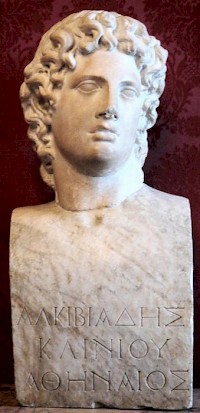
Nicias is not the only one who is to blame for the ultimate disaster. Some Athenians, including the popular leader Hyperbolus, wanted even bigger things, like an attack on Carthage. For the time being, however, the official plan was to support the allies only, and the unstated aim was to conquer the island. The commanders were Lamachus, Nicias, and Alcibiades. In 415, the expedition started.
Crisis in Command
When it arrived on Sicily and the allies started to have doubts, Lamachus proposed to attack Syracuse immediately. According to Thucydides, taking the main city of the island when it was still unprepared, was the best policy. Nicias proposed to support the allies and return home before the display of strength had diplomatically backfired. Alcibiades, the third commander, suggested to find more allies, create a supply base first, and attack Syracuse only after this build-up. In the end, his plan was adopted and Catana, north of Syracuse, became the Athenian supply base.

However, the element of surprise was now lost. Even worse, Alcibiades was recalled, leaving two commanders in charge who did not like the strategy they had embarked upon.
Beginning of the Siege
In the spring of 414, they laid siege to a Syracuse that had been prepared by its democratic leader Hermocrates. The most important improvement was that the northern part of the city had been surrounded by a new wall that made it impossible to storm Syracuse from the north, because there were dangerous rocks to descend before one could reach the wall. To the west of Syracuse was a marshy plain, so that the Athenians could only attack from the northwest. And so they did. Before the Syracusans were able to occupy the plateau known as Epipolae, the Athenians landed at Leon, gained access to the plateau at Euryalos, seized the plateau, and built a large fortress, called "the circle".
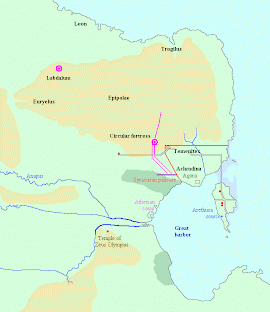
Now, a strange war of walling and counter-walling started. The Athenians knew that they had to hem in the Syracusans, so that they could starve them. They started to build a wall across Epipolae. One wall was to lead to Trogilus the north, and another to the south, to the Great Harbor. The Syracusans responded by digging a trench and building a palisade through the marshy area to the west, so that they would retain command of a road to the inland of Sicily. An elite regiment of Athenian soldiers, commanded by Lamachus, destroyed the palisade, but was unable to prevent an attack on the circular fortress, which could only be saved by setting fire to his supplies of wood. The siege engines were also destroyed. Worse, Lamachus was killed in action. Nicias, who was by now suffering from a serious illness, was left in charge.
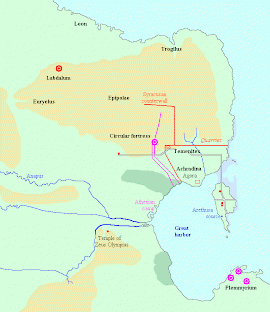
Still, the investment was almost complete; lack of timber prevented the immediate finishing of the northern wall, but this was a matter of time and the Syracusans were already preparing their surrender. And then, everything changed.
Gylippus Arrives
Unexpectedly, the Syracusans received reinforcements from Corinth and Sparta, commanded by Gylippus. Having stormed Euryalus, he marched north of the unfinished northern wall, and reached Syracuse. He immediately started to build a new counterwall that was to prevent the Athenians from finishing their northern wall. Nicias understood what was about to happen, but his soldiers were defeated by the Syracusan cavalry and could not prevent their enemies from finishing their counterwall. This was the decisive moment: it was now obvious that the Athenians could not invest Syracuse, which would always be able to obtain supplies. As if to stress this point, Gylippus also captured the Athenian base at Labdalum.
Nicias was unable to formulate a real response. He gathered many troops in three fortresses at Plemmyrium, south of the Great Harbor. It was something of a retreat to safety, which demoralized the men. Obtaining fresh water was difficult, because the Syracusans were superior in cavalry. Seeing that he was no longer besieging but was being besieged, Nicias wrote a letter to Athens, asking for a recall or reinforcements.
Reinforcing Failure
The Athenians preferred the second alternative and sent additional troops, commanded by Eurymedon, who arrived during the winter of 414/413, and Demosthenes, who arrived during the summer. This was a bold move, because the war with Sparta was about to start again and the Athenians could not afford to lose troops. (In 413, the Spartan king Agis II would occupy Decelea near Athens, which marked the beginning of the Decelean or Ionian War.) Perhaps the Athenians believed that success at Syracuse might deter other enemies.
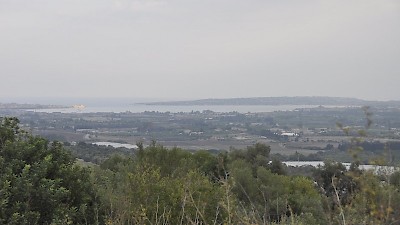
However, it was too late. Nicias had already been attacked by the Syracusan navy in the Great Harbor. The Athenians had been victorious, but at the same time, they lost Plemmyrium, which had been attacked by Gylippus. Worse was to come: in a second naval battle, the Athenians were defeated by the Syracusans, who had fortified their ships with stay-beams, so that they could ram their enemies bow on.
The Syracusans once been saved by the timely arrival of Gylippus. As if Fate wanted to restore a balance, or wanted to make sure that Athens would suffer even more, the same now happened to the Athenians: almost immediately after their naval defeat, Demosthenes arrived. Benefiting from the shock that the Syracusans experienced, he immediately tried to occupy the Epipolae plateau, but failed. He now concluded that it was best to break off the siege. It was a disgrace, but there was still an opportunity to minimize the losses. Nicias, however, was against it, and the two commanders decided to wait a bit longer, to see if the Syracusans might collapse - after all, there were reports that they had become weary of the war and were willing to come to terms with the reinforced Athenian army.
Destruction of the Athenian Army
However, the Syracusans continued to fight, and Nicias accepted Demosthenes' proposal. Unfortunately, during the night of 27 August 413, when the Athenians were supposed to sail away, there was a lunar eclipse, which Nicias thought was a very bad omen. He ordered to stay another month.
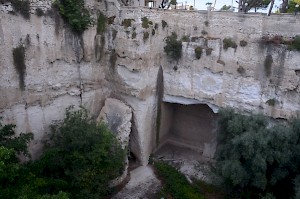
It became almost immediately apparent that this was a serious mistake. The Syracusans now started to block the entrance of the Great Harbor. The Athenians tried to break out, but were defeated in the final naval engagement. Now, finally, Nicias decided to leave his position. In fact, almost everything was lost, because the Athenians had no ships to return home. Still, they tried to reach the safety of Catana in the north, but they were attacked by the Syracusan cavalry and were unable to make much progress.
On the sixth day of their march, they gave up, and decided to move to the south - something that the Syracusans had not expected them to do. But it did not improve the situation for the Athenians. Demosthenes' troops fell behind and surrendered on the condition that the soldiers would not be killed. Even slavery was now acceptable. On the seventh day, Nicias was able to defeat his pursuers one more time, but in the end, his men were unable to continue, and surrendered as well (text).
This was the end of the Sicilian expedition. Those survivors who belonged to the Athenian alliance, the Delian League, were sold as slaves. The Athenians were forced to work in a stone quarry, today called "Latomia dei Cappuccini", where they died from malnutrition and exposure. Demosthenes and Nicias were put to death. The booty was immense; the Syracusans were able to built a splendid treasury in Delphi to store one tenth of the proceeds of this war.

Because Thucydides' account of the siege of Syracuse is a literary masterpiece, the war has always remained part of the collective memory of western civilization. Syracuse, which was fortified with formidable walls in the years after the siege, was believed to be impossible to capture, and when the Roman general Marcellus in 212 finally took the city, treason played a role. It is said that during the Second World War, the American general Patton wanted to invade Sicily and capture Syracuse, only because the Athenians had been unsuccessful.